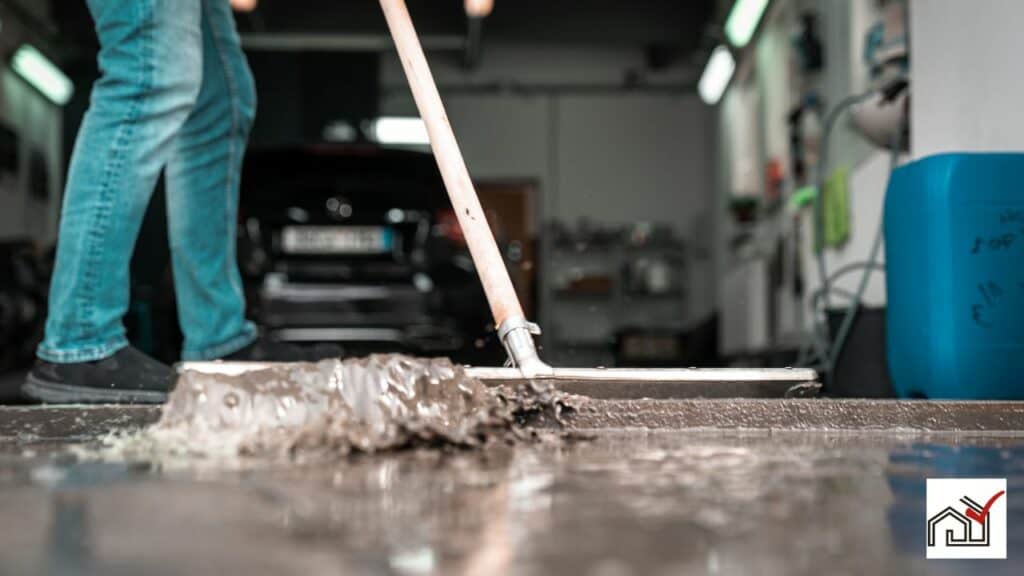To clean a garage floor after winter, first inspect the floor for any chemical or oil stains. Remove all items from the garage to make sweeping easier.
Clean the floor using a concrete-safe cleaner and scrub vigorously to remove stains. Rinse the floor thoroughly and allow it to dry.
Apply a sealant to protect the floor from future damage.
Assess the Floor's Condition
Before cleaning the garage floor, inspect it for stains, cracks, or damage caused by winter conditions. Freezing and thawing, road salt, and deicing chemicals can cause surface and structural problems. Check for compromised floor coatings and salt residue that may have caused white stains or a dusty look due to moisture attraction. Neglecting these issues can worsen the damage.
Ensure no standing water is present, which could indicate blocked drainage. Identify any vehicle fluid stains or chemical spills. Assess the floor to determine the cleaning level needed and if repairs are necessary before re-coating. The aim is to maintain the floor's condition and prepare it for future use.
Clear and Organize Items
To clean your garage floor, start by removing all items and organizing them on shelves or in bins. This is essential for both accessing the floor and keeping the garage tidy. After winter, sort through items, storing what you won't need and keeping others within reach.
Shelving and bins help you categorize things like sports gear and decorations while preventing pests from nesting. With items stored away, the floor is clear for cleaning, allowing you to see and address any stains or damage.
Once the floor is clear, you can then choose the right cleaning solutions and tools. Clearing and organizing your garage enables a more effective cleaning process, resulting in a clean and orderly garage floor.
Sweep Away Solid Debris
After organizing your garage, sweep away all solid debris like dirt, salt, and snow remnants. Snowmelt often brings road salt and mud, especially near the garage door and on the floor. This can damage concrete over time.
Use a strong push broom for this task. Start in the corners and sweep toward the door to keep debris contained. Focus on areas with salt deposits from melted snow, as they may be dirtier.
For hard-packed snow and ice, use a snow scraper to break it up. Regular sweeping or vacuuming throughout the year can help maintain your concrete floor.
To address oil or grease stains, apply sawdust or kitty litter before sweeping again. This prepares the floor for wet cleaning with dishwashing detergent or a concrete cleaner to fully clean the surface.
Pre-treat Stubborn Stains
Apply a pre-treatment solution directly to stubborn stains before cleaning. This helps break down the stain, especially on garage floors with epoxy coatings, making it easier to clean.
For epoxy-coated floors, use a mild Simple Green solution. It's eco-friendly and won't damage the coating. Cover the stains with the solution and wait a few minutes for it to work.
For uncoated concrete floors, use a mixture of one cup of vinegar, a gallon of warm water, and dish soap to treat salt stains. Apply it to the stains and let it sit to break down the residue. You may need to repeat this for tough stains.
Allow the pre-treatment to sit long enough to soften the residue for more effective cleaning.
Apply a Deep-Cleaning Solution
After the pre-treatment has done its job, apply a deep-cleaning solution to the garage floor to eliminate salt and debris. This is important to maintain a clean floor and prevent damage from corrosive substances left by melted ice and snow.
For floors with epoxy coatings, use a cleaner like Salt-Away, designed to counteract winter's residues, including salt and deicing chemicals, which can cause surface damage. Follow the cleaner's instructions precisely, which may include diluting it. Scrub the floor with a stiff brush, focusing on heavily soiled areas. Epoxy coatings help by stopping substances from penetrating, making them easier to clean off.
Rinse the floor well with water to remove all cleaning agents and salt. You may need to repeat this to entirely remove salt residue.
For further protection, seal the clean floor with a siliconate sealer. This helps repel road salt and deicing fluids, extending the floor's lifespan.
Scrub and Rinse Thoroughly
Scrubbing and rinsing thoroughly are critical to remove salt and debris from your garage floor after winter. The floor may be covered with road salts, melted snow, and contaminants that can damage the floor if not cleaned. To remove these residues, scrub and rinse the floor well.
Start by applying a vinegar solution to salt stains to help dissolve the salts for easier scrubbing. Use a stiff brush to scrub the treated areas, as this helps to remove particles from the floor's pores.
After scrubbing, rinse the floor with plenty of water to remove debris and cleaning solution. Ensure that no residue is left, as it can cause further damage. Rinse again if salt residue persists.
For thorough cleaning, use a shop vac to remove any remaining moisture and particles from the concrete. This helps in drying the floor and removing salts and cleaners.
Dry and Apply Sealant
Ensure the garage floor is completely dry after cleaning to remove salts and debris. If necessary, use fans or dehumidifiers to speed up the drying process, especially in humid conditions or cooler temperatures that can extend drying times.
Once dry, check the concrete for any remaining impurities or damage. If the floor is clean and undamaged, proceed to apply a high-quality siliconate sealer. This sealer penetrates the concrete and creates a protective barrier against road salts, deicing fluids, and prevents the formation of spalling and white stains.
Apply the sealant according to the manufacturer's instructions. Use a sprayer or roller for even coverage, avoiding pooling. Allow the sealer to penetrate for the recommended time, then wipe away any excess before it dries.
Consider using a concrete densifier with sealer for extra protection against liquids and salts.
Properly sealing the garage floor is essential to maintain its condition and prevent damage from moisture and freeze-thaw cycles.





